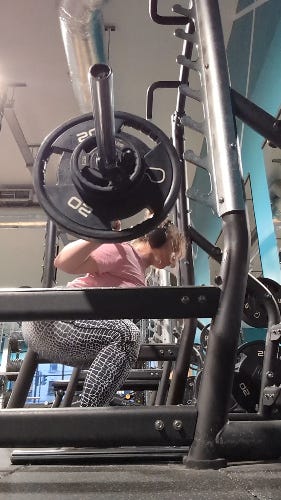Welcome back! It’s January, so I’m just going to assume that some of you are thinking about instigating new and improving habits, which means I’m giving myself licence to hector you about weightlifting. If you follow me on Instagram, you’ll already know that weightlifting is my form of main exercise. Specifically, what I do comes under the heading of powerlifting, because I focus my training on the so-called “big three” barbell lifts that add up to a powerflifter’s total in competition — deadlift, squat and bench (although I don’t compete and I’ve got no plans to).
Really, the deadlift (pulling the bar straight up off the floor) and the squat (holding the bar across your shoulders and, um, squatting) are the important ones. I know some people (men) are very attached to their bench number as a sign of ultimate strength, but it’s not that great of an exercise and I only do it because I’m a bit of an anxious completist. Other people feel deterred from the whole weightlifting thing by the bench, which after all involves holding a heavy bar over your prone body and the attendant worry of dropping it on your tender face/neck/chest.
That isn’t actually likely to happen — if you fail on bench, you’ll probably just end up with it pinned embarrassingly across your chest as you arms refuse to budge it, leaving you to wriggle out with a few bruises and everyone else in the gym to pretend they didn’t see (yes, this is a story from real life). Even so, you’ll get a better workout for your chest doing bodyweight pressups, and a better workout for upper body strength doing overhead presses, which have much better application for day-to-day life.
Weightlifting, especially for women, is one of those things that the whole world seems to have caught up with over the last ten years or so
Weightlifting, especially for women, is one of those things that the whole world seems to have caught up with over the last ten years or so. Partly that’s because the health benefits are large and undeniable: doing anything that sustains your muscle mass (or even better, increases it) is a particular boon if you’re approaching the hormonal decline of middle age and have the kind of sedentary lifestyle most of us have. (One of my motivations for hiring my PT was turning 40.) But it’s also because there was a shift in beauty standards, away from size-zero skinny and towards curvy. Hey, you can read about this in the Kim Kardashian chapter of my book!
If you want a big bum, you need big glutes; and if you want big glutes, you better start shifting some weights. (Although I really don’t recommend the endless glute thrusts that you’ll see girls grinding through the gym — an annoying exercise that takes ages to set up, does much less than promised and is easy to do badly. Deadlifts, Romanian deadlifts and lunges are your friends here.) Furthermore: if you want to look hourglassy, your best bet isn’t doing a zillion crunches in the hope of thinning out your waist, because crunches don’t burn fat. (Being in a calorie deficit burns fat, and there’s no way to lose it from one bit of your body only.) Your best bet is to get bigger shoulders which, once again, is going to involve shifting some weights.
a part of me aspires to see my body only as a machine for living, not a thing to be looked at
It feels a little shameful to admit that I had an aesthetic as well as a health motivation for getting into lifting — a part of me aspires to see my body only as a machine for living, not a thing to be looked at. But this is a pointless fight to get into with myself, or rather, with the decades of social conditioning that have got me to where I am. I do see my body as (among other things) a thing to be looked at, and I don’t see the point in making myself feel bad about preferring to feel good about how it looks.
What I will say about weightlifting is that, more than any other form of exercise I’ve tried, it’s shifted my own understanding of what the aesthetics of my body mean. When I ran a lot (something I love for its own sake and am going to devote more time to in 2024), I still thought a lot about thinness as my ultimate goal, and that can be a very unhappy preoccupation for me. I found the same with yoga and barre — again, things I really enjoy, but which both have an embedded culture of litheness that seems to push my worst buttons. (Your worst buttons may of course vary.)
With weightlifting, I instead think of the appearance of my body as a sign of what my body can do: my back looks like this because I can pull 100kg up off the floor. And being stronger is something you will notice in every part of your life, from the casual competence with which you can lug shopping bags around to the dazzling lack of back pain you’ll experience when your hunched at your laptop. It’s a subtle and incomplete difference, but whereas once I seemed to haunt my own shell and find it ever wanting, this feels like coming home to the body I have always been.
If you have anything you’d like to ask me about weightlifting, please leave a comment or reply to this email. Seriously, I could bore on for years.
Listened
Les Savy Fav, “The Equestrian”
Think of this as a consequence of the ongoing Saltburnisation of my listening habits: everything from the 2007 Pitchfork 100 is back in rotation, including Les Savy Fav and this spectacularly filthy song which is absolutely great for lifting. In fact, the whole Let’s Stay Friends album is a pretty strong gym album: warm up to the slow opener, “Pots and Pans”, then hit your first proper lift as singer Tim Harrington yelps out the opening line of “The Equestrian” (“smells like leather, tastes like sweat”) into a storm of hardcore guitars, followed by whole bunch of very specific horse imagery in the lyrics that strongly imply the other kind of riding.
Watched
The South Bank Show: Kathy Acker (YouTube)
One of my minor ongoing concerns is whether, as my forties progress, I’m transitioning into the avant garde novelist Kathy Acker. The case for: weightlifting, tattoos, increasingly aggressive bleaching of my hair. I find Acker’s work invigorating and infuriating in equal parts, but I find her personally fascinating — one of the small number of women who have a genuine claim to the title of “art monster”, to borrow from Claire Dederer. (And even then, her monstrousness is pretty small fry compared to what male terrors of the bourgeoisie have gotten up to.) This 1984 episode of The South Bank Show has incredible access to Acker as she goes about her scuzzy New York life. Don’t ruin it for yourself by wondering whether ITV, or even BBC2, would ever make anything like this today, because they wouldn’t.
Read
Chris Kraus, After Kathy Acker: A Biography (Penguin)
All my reading over Christmas was for reviewing, so here’s a throwback to Chris Kraus’s Kathy Acker biography. There was another biography last year, tagged as the “first full-scale authorised biography”, which suggests there’s some stuff missing from this — I’m interesting in reading it and making the comparison. Kraus, who I do not massively enjoy as a novelist (I Love Dick left me considerably colder than I expected it to), is a great narrator of Acker’s life as a one-woman wave of emotional terrorism. (I reviewed this for Literary Review if you want my full take.)
One of the most indelible anecdotes: Acker recruited a lover to make an art-porno with her which reportedly left her co-performer so psychologically demolished that he has never watched it. It’s also good on Acker’s contorted relationship to the/her body: part of her fascination with weightlifting (specifically body building in her case) was a desire to integrate body and mind in the pursuit of artistry. And yet her death — from a cancer that would have been curable had she not believed the mind-over-body lies of alternative therapists — suggests that Acker’s accommodation with her own physicality failed at the end.
Gimme, gimme more…
The Olivia Rodrigo album is a perfect 1990s artefact (me for The Critic).
Can you bear to think about Christmas TV at this point? I reviewed it for the Sunday Times: Ghosts good, that Christie adap very much not.
Thanks to Scott Wortley for solving the mystery of when I watched Peeping Tom: it was on Channel 4 in 1997 and accompanied by this documentary, making me an entirely wholesome 16 at the time of viewing.







my job is...just bench
YESSSSSSS BRUV - SQUATS SQUATS SQUATS